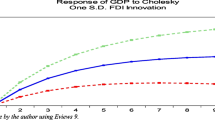Abstract
This study investigates monetary policy and capital flow implications on economic growth in emerging economies so-called BRICS countries between 2001 and 2015. The causality results revealed a unidirectional causality from foreign direct investment and broad money to total reserves, real GDP per capita and broad money to total reserves, broad money to total reserves and real interest rates as a percentage, foreign direct investment and commercial bank and another lending, total changes in external debt stock and commercial bank and another lending, foreign direct investments and real interest rates as a percentage, foreign direct investment and domestic credit provided by the financial sector, and domestic credit provided by the financial sector and real GDP per capita. A bidirectional causality holds for domestic credit provided by the financial sector and broad money to total reserves, and real interest rates as a percentage and commercial bank and another lending. The results suggest that policies should include restrictions on capital flows, targeted monetary policy for both money supply and interest rates, an external debt ceiling, broadening financial regulations, and domestic institutional strengthening.
Similar content being viewed by others
Availability of data and material
The datasets used and/or analyzed during the current study are available from the corresponding author on reasonable request.
References
Ahmed, S., & Zlate, A. (2014). Capital flows to emerging market economies: A brave new world? Journal of International Money and Finance, 48, 221–248.
Aizenman, J., & Binici, M. (2016). Exchange market pressure in OECD and emerging economies: Domestic vs. external factors and capital flows in the old and new normal. Journal of International Money and Finance, 66, 65–87.
Byrne, J. P., & Fiess, N. (2016). International capital flows to emerging markets: National and global determinants. Journal of International Money and Finance, 61, 82–100.
Chedwick, M. G. (2018). Effectiveness of monetary and macroprudential shocks on consumer credit growth and volatility in Turkey. Central Bank Review, 18(2), 69–83.
Chamon, M., & Garcia, M. (2016). Capital controls in Brazil: Effective? Journal of International Money and Finance, 61, 163–187.
Coşkun, Y., Seven, Ü., Ertuğrul, H. M., & Ulussever, T. (2017). Capital market and economic growth nexus: Evidence from Turkey. Central Bank Review, 17(1), 19–29.
Dumitrescu, E. I., & Hurlin, C. (2012). Testing for Granger non-causality in heterogeneous panels. Economic Modelling, 29(4), 1450–1460.
Ekici, O., & Nemlioğlu, K. (2017). Emerging economies’ short-term private external debt as evidence of economic crisis. Journal of Policy Modeling, 39(2), 232–246.
Forbes, K., Fratzscher, M., & Straub, R. (2015). Capital-flow management measures: What are they good for? Journal of International Economics, 96, S76–S97.
Giordani, P. E., Ruta, M., Weisfeld, H., & Zhu, L. (2017). Capital flow deflection. Journal of International Economics, 105, 102–118.
Han, X., & Wei, S. J. (2018). International transmissions of monetary shocks: Between a trilemma and a dilemma. Journal of International Economics, 110, 205–219.
Hutchison, M. M., Sengupta, R., & Singh, N. (2013). Dove or Hawk? Characterizing monetary policy regime switches in India. Emerging Markets Review, 16, 183–202.
Im, K. S., Pesaran, M. H., & Shin, Y. (2003). Testing for unit roots in heterogeneous panels. Journal of Econometrics, 115(1), 53–74.
Issahaku, H., Harvey, S. K., & Abor, J. Y. (2016). Does development finance pose an additional risk to monetary policy? Review of Development Finance, 6(1), 91–104.
Ivan, M., & Muresan, J. D. (2010). The Implications of Globalization upon the International Banking Activities. In The 14th International Business Information Management Association Conference-Business Transformation through Innovation and Knowledge Management an Academic Perspective IBIMA Proceedings (pp. 2261–2267).
Jamilov, R. (2013). Capital mobility in the Caucasus. Economic Systems, 37(2), 155–170.
Koepke, R. (2018). Fed policy expectations and portfolio flows to emerging markets. Journal of International Financial Markets, Institutions and Money, 55, 170–194.
Kara, H. (2016). A brief assessment of Turkey’s macroprudential policy approach: 2011–2015. Central Bank Review, 16(3), 85–92.
Levin, A., Lin, C. F., & Chu, C. S. J. (2002). Unit root tests in panel data: Asymptotic and finite-sample properties. Journal of Econometrics, 108(1), 1–24.
Radulescu, I. G., Panait, M., & Voica, C. (2014). BRICS countries challenge to the world economy new trends. Procedia Economics and Finance, 8, 605–613.
Sahay, M. R., Arora, M. V. B., Arvanitis, M. A. V., Faruqee, M. H., N'Diaye, M. P., &Griffoli, M. T. M. (2014). Emerging market volatility: Lessons from the taper tantrum (No. 14–19). International Monetary Fund.
Samarina, A., & Bezemer, D. (2016). Do capital flows change domestic credit allocation? Journal of International Money and Finance, 62, 98–121.
Steiner, A. (2017). Central banks and macroeconomic policy choices: Relaxing the trilemma. Journal of Banking & Finance, 77, 283–299.
Subic, J., Vasiljevic, Z., & Andrei, J. (2010). The impact of FDI on the European economic development in the context of diversification of capital flows. Proceedings of the 14th International Business Information Management Association, Business Transformation through Innovation and Knowledge Management: An Academic Perspective, Istanbul, Turkey, 23–24.
Taguchi, H., Sahoo, P., & Nataraj, G. (2015). Capital flows and asset prices: Empirical evidence from emerging and developing economies. International Economics, 141, 1–14.
World Bank (2018). World Development Indicators. World Bank, Washington DC.
Funding
There is no funding sources.
Author information
Authors and Affiliations
Contributions
EA and SH wrote this paper, read and approved the final manuscript.
Corresponding author
Ethics declarations
Conflict of interest
On behalf of all authors, the corresponding author states that there is no conflict of interest.
Additional information
Publisher's Note
Springer Nature remains neutral with regard to jurisdictional claims in published maps and institutional affiliations.
Rights and permissions
About this article
Cite this article
Akalpler, E., Hove, S. Monetary policy and capital flow implications on economic growth in BRICS countries. IJEPS 16, 253–274 (2022). https://doi.org/10.1007/s42495-021-00076-z
Received:
Accepted:
Published:
Issue Date:
DOI: https://doi.org/10.1007/s42495-021-00076-z






